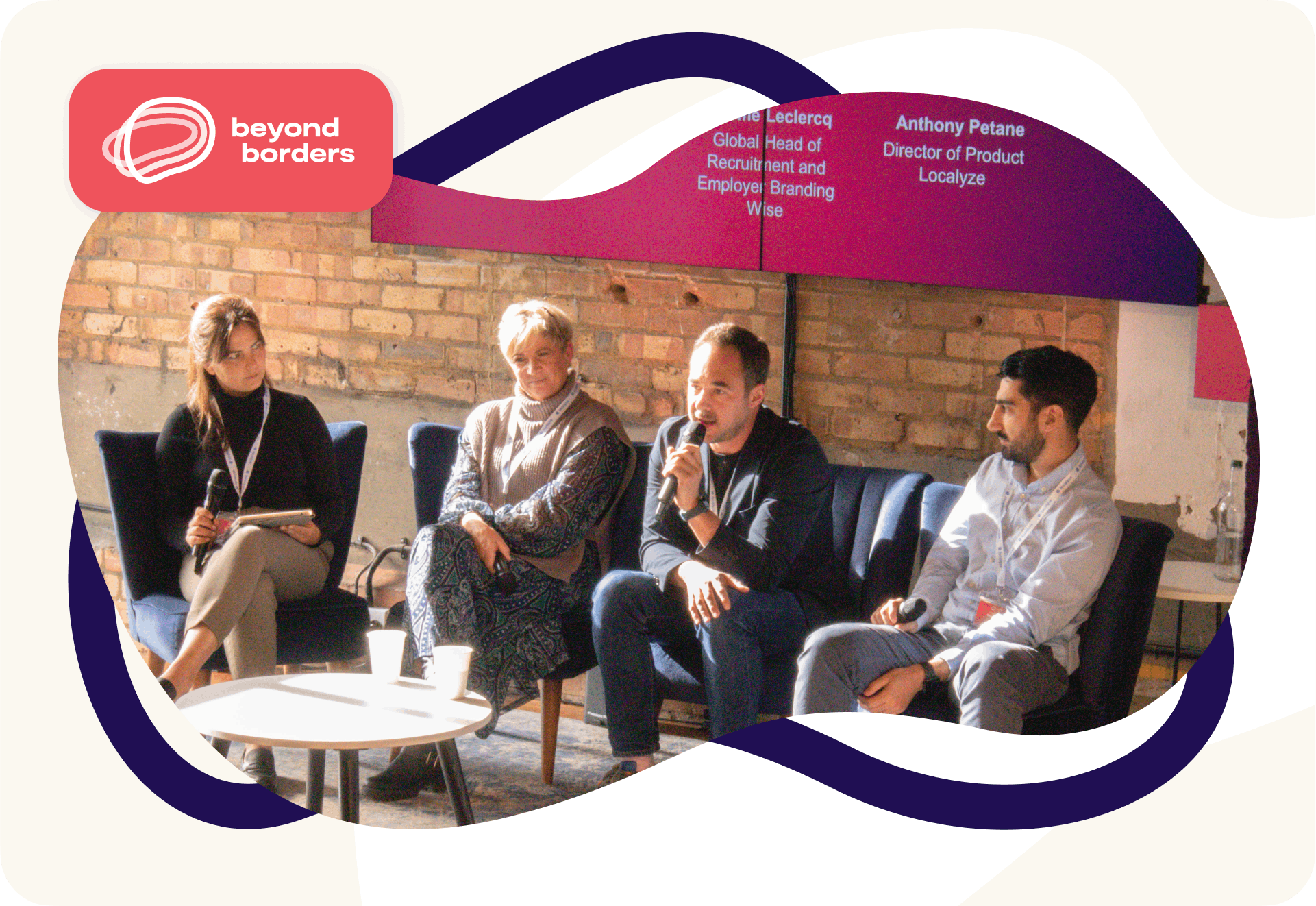When it comes to Global Mobility, sometimes you just have to wonder: what do other companies really do? What works for them? What doesn't? What do others in comparable roles see as upcoming trends? One way to get answers to questions like these is to gather people in similar roles in the Global Mobility industry and ask them directly. We did exactly that through our Beyond Borders event series a few weeks ago. During the event, we organized roundtable sessions for participants to discuss five key topics at the forefront of the Global Mobility industry.
The topics of the day were:
- Planning ahead for 2024
- Navigating the future of Global Mobility: key success factors for the next 18 months
- The value of hiring expat talent
- Maximizing employee engagement through tech
- Effective management of international teams
In these roundtable discussions, participants were able to voice their experiences and ideas. We’ve summarized some of their thoughts here so you can see what’s trending for the year ahead.
Planning ahead for 2024
We asked participants 1) to identify key steps and strategic considerations for planning in 2024, considering emerging trends, and changing workplace expectations, and 2) to discuss the balance between employee well-being and organizational success.
Strategic considerations, emerging trends, changing expectations
In terms of trends, cost consciousness was a major theme. This in turn leads to changes in the way positions are filled: quality and strategic needs come before quantity when it comes to hiring. Some organizations are looking to invest more in their existing team rather than hiring. This focus on keeping costs in check will impact how much of a demand there is for Global Mobility and what aspects teams prioritize.
Another trend is the move toward more in-person (as opposed to remote) work, which has been shown to be a big reason people switch jobs to keep their remote flexibility. However, often the people who make the decision to require employees to be on-site are not the same people who will deal with the fallout. It’s clear there’s no single right answer, and it comes down to the best move for each organization. Many companies are finding that being flexible is important to balance attrition with other organizational needs.
Sustainability is also one of the biggest challenges in the industry. Securing investor money going forward may hinge on being more sustainable. Environmental impact can also influence employer branding, which in turn impacts hiring and retention. That said, knowing which choices are the best in terms of sustainability is key. The data exists, but the experts within organizations need to have a voice in decisions, and not all organizations have someone dedicated to this type of role.
The balance between employee well-being and organizational success
When considering employee well-being, it is important to recognize that employees are unique when it comes to what they value and how they adapt when moving to a new location. Here are some tips for success:
- Determining which well-being KPIs to use is important.
- Communication – both during hiring and after – is key, regardless of whether employees are remote or local.
- Employee mental health needs prioritization: when initiatives exist, employees need to understand what they’re for.
- Other items key to well-being include a focus on culture, the ability to collaborate across regions, providing support to employees, and keeping people connected.
Finally, remember that adaptability and resilience are factors in success, both for individuals and organizations. Both need to be able to adapt to the changing environment and remain resilient. Working remotely has allowed people to adapt their work schedules around their lives more efficiently and take the time to do things they value. This creates stability in the workforce because employees value this as a benefit and are less likely to leave.
Navigating the future of Global Mobility: key success factors for the next 18 months
Figuring out where Global Mobility fits within an organization is a key component to success. Many organizations lump it together with rewards and benefits, but the two are not interchangeable; mobility can be a function within rewards and benefits, but Global Mobility encompasses more. Some organizations incorporate it with HR, but that also downplays its importance because Global Mobility professionals handle more than just relocations.
Given this, determining where to locate within (or separate from) the rewards/benefits/talent/HR spheres can impact how well the Global Mobility team functions. Another consideration is that most organizations do not have a senior leadership role dedicated to Global Mobility – though some did put such a role in place during the pandemic, specifically related to remote working – this means there may not be a seat at the table during strategic discussions.
The value of hiring expat talent
How do you assess the value of hiring international talent as opposed to focusing solely on candidates within the country? The short answer is the value of bringing expat talent depends on the role. For example, tech skills are in demand and there is a concentration of tech talent in Asia. Conversely, how feasible hiring expats is depends on where the role will be located and whether that location is desirable to international talent.
Here are some of the benefits of hiring expat talent that came up during the Beyond Borders discussions:
- Expat talent can sometimes join at a lower compensation level than local talent because they’re being provided with the added benefit of international opportunities.
- New talent can bring international expertise.
- Diversity helps increase innovation and brings new ideas.
- It creates a larger candidate pool.
There are also challenges:
- Several aspects of hiring expat talent can increase the time-to-hire, such as ensuring certificates and other qualifications are equivalent to local standards and completing the visa process. This extra time can often be mitigated by allowing remote work in the interim, but this is not always ideal. Either way, when the process takes too long, good candidates may look elsewhere.
- When cultural training is not robust, it can result in a reduction in how well a new employee fits in with the team.
- The experience of relocating to a new country can be traumatic even when welcomed and sought after; emotional support is required to reduce attrition.
- Providing support for spouses is important but often underutilized and can lead to unhappiness.
- Budgets may have to be shifted to accommodate relocation costs.
Maximizing employee engagement through tech
How does technology transform the way organizations engage with their employees? How can technology bridge the gap between on-site and remote employees?
Across multiple organizations, tech tools that allow communication, like Slack or Teams, help to maintain flexibility; conversely, in-person time still matters for synergy building. Social events can help, and should include volunteering opportunities. However, bear in mind that event and schedule planning should consider public events like holidays that are relevant to each of the cultures represented on the team.
Another way tech assists is with gathering feedback. Surveys via online platforms like SurveyMonkey can be utilized to capture employee input as the basis for determining the ROI of various initiatives. Other tech tools mentioned by name during Beyond Borders were: Peakon, Personio, OnHand, Rippling, Tactic, Notion, Otta, and Learnably, all used by participant organizations.
While leveraging technology, it’s equally important to offer enough time off that is focused on mental health and the transition to a new location. For example, days dedicated to well-being, nesting leave, and compassionate leave, can all be utilized in addition to flexible holidays. Tech can also be used to address mental health; for example, some organizations use mental health platforms like Mindsurance to find professionals who can assist employees who have relocated.
Effective management of international teams
How do you ensure effective collaboration and productivity in international teams while addressing cultural diversity, time zones, and communication challenges? First, plan around challenges up front, such as:
- You may need to move a whole family, not just an individual. This comes with its own hurdles.
- Language needs will differ for each hire.
- There may be immigration hurdles, which will be specific to the country of the employer and employee.
- Showing empathy is even more important than in local hiring.
The consensus is that hiring expat talent will continue, and international teams will remain common. That said, the various ways organizations manage this (whether offering expat jobs, remote work, or a hybrid) can become complicated. When building teams where people haven’t met, here are some tips:
- Schedule 1:1 time for those who don’t work in the same place; ensure it’s neutral in location.
- Create formal communication paths.
- Have a consistent onboarding program.
- Schedule parties and other entertainment.
If you're interested in delving deeper into our Beyond Borders theme, join us for two engaging digital fireside chats. Check out the details below and don't hesitate to registered for both webinars!
How to attract skilled talent to Europe, according to a member of the European Parliament
- Speaker: Damian Boeselager, MEP and Co-Founder of Volt Europa
- Host: Hanna Marie Asmussen, Co-Founder and CEO of Localyze
- Date: Tuesday, November 28th
- Time: 3:00 to 4:00 pm CET
- Sign up here
How to convince your leadership that immigration support can retain and nurture critical talent
- Speaker: Sybille Schneider, Global Mobility & Immigration Manager at Cognizant
- Host: Stephanie Jade Thomas, Talent Acquisition Lead at Localyze
- Date: Wednesday, November 29th
- Time: 12:30 pm to 13:30 pm CET
- Sign up here
The world of Global Mobility is complex, but Localyze makes it easier for your company to offer relocation services to employees. From business trips to relocations, and everything in between. Click here to book a demo today.


